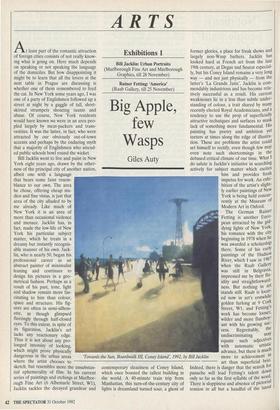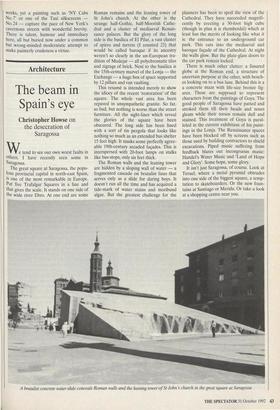ARTS
Exhibitions 1
Bill Jacklin: Urban Portraits (Marlborough Fine Art and Marlborough Graphics, till 28 November) Rainer Fetting: 'America' (Raab Gallery, till 25 November)
Big Apple, few Wasps
Giles Auty
A 1
t least part of the romantic attraction of foreign cities consists of not really know- ing what is going on. Here much depends on speaking or not speaking the language of the domiciles. But how disappointing it might be to learn that all the lovers at the next table in Prague are discussing is whether one of them remembered to feed the cat. In New York some years ago, I was one of a party of Englishmen followed up a street at night by a gaggle of tall, short- skirted strumpets shouting taunts and abuse. Of course, New York residents would have known we were in an area peo- pled largely by meat-packers and trans- vestites. It was the latter, in fact, who were attracted by our obviously out-of-town accents and perhaps by the enduring myth that a majority of Englishmen who attend- ed public schools bowl round the wicket.
Bill Jacklin went to live and paint in New York eight years ago, drawn by the other- ness of the principal city of another nation, albeit one with a language that bears some faint resem- blance to our own. The area he chose, offering cheap stu- dios and fine vistas, is just that area of the city alluded to by me already. Like much of New York it is an area of more than occasional violence and menace. Jacklin has, in fact, made the low-life of New York his particular subject matter, which he treats in a dreamy but instantly recognis- able manner of his own. Jack- lin, who is nearly 50, began his professional career as an abstract painter of minimalist leaning and continues to design his pictures in a geo- metrical fashion. Perhaps as a result of his past, tone, light and shadow remain more fas- cinating to him than colour, space and structure. His fig- ures are often in semi-silhou- ette, as though glimpsed fleetingly through half-closed eyes. To this extent, in spite of its figuration, Jacklin's art lacks any reactionary edge. Thus it is not about any pro- longed intensity of looking, which might prove physically dangerous in the urban areas where the artist chooses to sketch, but resembles more the unsubstan- tial ephemerality of film. In his current series of paintings and etchings at Marlbor- ough Fine Art (6 Albemarle Street, W1), Jacklin tackles the decayed grandeur and Bill Jacklin Towards the Sun, Boardwalk III, Coney Island, 1992, by contemporary sleaziness of Coney Island, which once boasted the tallest building in the world. A 40-minute train trip from Manhattan, this turn-of-the-century city of lights is dreamland turned sour, a ghost of former glories, a place for freak shows and largely non-Wasp bathers. Jacklin has looked hard at French art from the late 19th century, at Degas and Seurat especial- ly, but his Coney Island remains a very long way — and not just physically — from the latter's 'La Grande Jatte'. Jacklin is com- mendably industrious and has become rela- tively successful as a result. His current weaknesses lie in a less than subtle under- standing of colour, a trait shared by many recently elected Royal Academicians, and a tendency to use the prop of superficially attractive techniques and surfaces to mask lack of something more fundamental. His painting has poetry and ambition yet teeters at times along the edge of illustra- tion. These are problems the artist could set himself to rectify, even though few may even note such shortcomings in the debased critical climate of our time. What I do salute is Jacklin's initiative in searching actively for subject matter which excites him and provides fresh impetus for work. An exhi- bition of the artist's slight- ly earlier paintings of New York is being held concur- rently at the Museum of Modern Art in Oxford.
The German Rainer Fetting is another Euro- pean attracted by the gid- dying lights of New York, his romance with the city beginning in 1978 when he was awarded a scholarship there. Some of his early paintings of the Hudson River, which I saw in 1987 when the Raab Gallery was still in Belgravia, impressed me by their flu- idity and straightforward- ness. But nothing in art stands still. Raab is locat- ed now in art's erstwhile golden furlong at 9 Cork Street, Wl, and Fetting s work has become looser, wilder and more flamboy- ant with his growing suc- cess. Regrettably, the undiscriminating may works, yet a painting such as 'NY Cabs No.7' or one of the Taxi silkscreens — No.24 — capture the pace of New York's cavernous streets with wonderful brevity. There is talent, humour and immediacy here, all but buried now under a common but wrong-minded modernistic attempt to make painterly crudeness a virtue.



























































 Previous page
Previous page